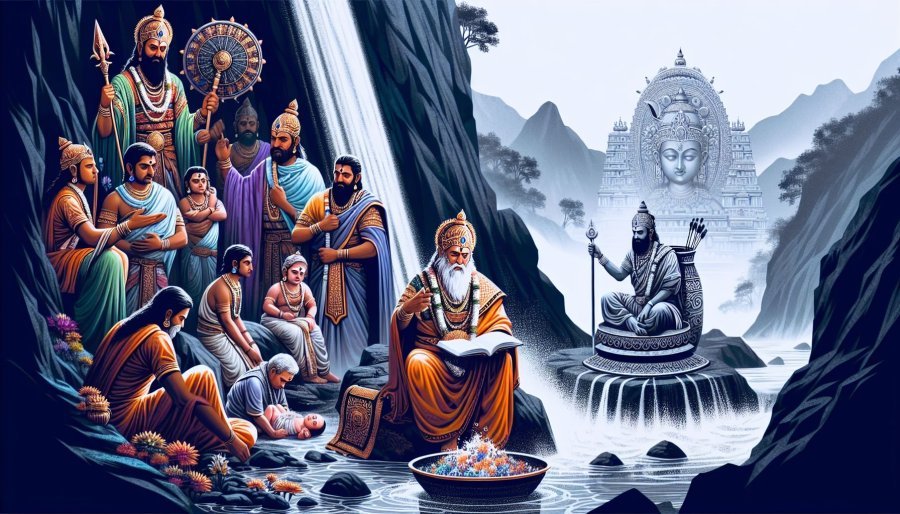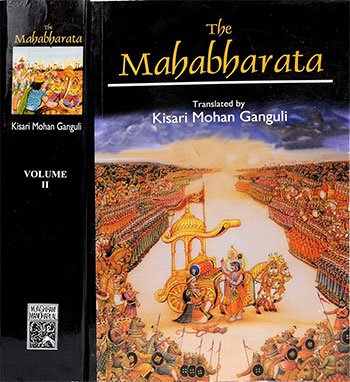Section CLXXIX - Vasishtha's Return to Ayodhya: The Birth of Asmaka
Book index: Mahabharata (English)
This page contains a summary of the Mahabharata Section CLXXIX including examples of moral lessons in daily life. The Maha-Bharata is one of the largest epics ever written containing roughly 100,000 Sanskrit verses. It deals with the legendary history of ancient India and contains a large number of interwoven tales.

Short summary of the chapter:
The story follows the Muni Vasishtha who, grieving the loss of his children, attempts to drown himself in a river but is saved by the current, which breaks his cords. He wanders in despair, encountering a pregnant Adrisyanti, daughter-in-law of his son Saktri, who has been reciting the Vedas. Hearing her voice, he regains hope and returns to his hermitage. There, he encounters King Kalmashapada, who had been cursed and turned into a Rakshasa by the sage's son, and Vasishtha frees him from the curse, restoring his reason and power.
Feeling grateful for being saved, the king promises to never insult Brahmanas again and seeks Vasishtha's help to have a son to continue the Ikshvaku lineage. Vasishtha agrees and accompanies the king back to Ayodhya where he blesses him with a son. The citizens welcome them joyously, and the king's presence fills the city with splendor and joy. Vasishtha then unites with the queen, who gives birth to Asmaka, the founder of the city of Paudanya.
The story highlights Vasishtha's journey from despair to hope, showcasing his ability to overcome challenges and bring about positive change in the lives of others. It also emphasizes the importance of respecting Brahmanas and seeking their guidance for a prosperous and peaceful kingdom. Ultimately, the story brings out themes of redemption, forgiveness, and the power of divine blessings in shaping the destiny of individuals and dynasties.
Full English translation:
This page is merely a summary which is automatically generated. If you are looking for authentic sources such as the Sanskrit text or the Full English translation of Mahabharata Section CLXXIX - Vasishtha's Return to Ayodhya: The Birth of Asmaka, have a look at the following articles:
Section CLXXIX, online text
English translation by Kisari Mohan Ganguli.
Read this and other chapters online.
Mahabharata (English Summary)
by Kisari Mohan Ganguli | ISBN-10: 8121505933
Buy the latest edition:
FAQ of Mahabharata, Section CLXXIX:
What was the reason behind Vasishtha's self-destructive actions in the story?
Vasishtha's grief over losing his children led him to attempt self-destruction, seeking an end to his suffering by throwing himself into dangerous rivers.
How did Vasishtha ultimately avoid self-destruction?
The sound of his daughter-in-law reciting the Vedas with great skill and intelligence, along with the assurance of a grandchild, turned the tide for Vasishtha, leading him to refrain from harming himself.
Who ultimately helped King Kalmashapada overcome his curse in the story?
Vasishtha, through his powerful energy and knowledge, restrained Kalmashapada and freed him from the curse that had plagued him for twelve years. The king was then able to regain his senses and seek guidance.
What was the outcome of Vasishtha's presence in King Kalmashapada's kingdom?
Vasishtha granted the king's wish for a son to continue the Ikshvaku lineage, accompanying the monarch back to Ayodhya. The city celebrated their return, and the queen ultimately gave birth to Asmaka, the founder of Paudanya.
Daily life: Vasishtha's Return to Ayodhya: The Birth of Asmaka:
The tale intricately weaves a narrative of resilience, redemption, and the power of faith in the face of adversity. It tells us that even when confronted with the harshest of life's storms, be it the loss of loved ones, the threat of danger, or the struggle with one's inner demons, there is a resilience within us all that can help us endure and emerge stronger. The story exemplifies how surrendering to our despair and seeking an end to our suffering may not always be the solution we think it is. Instead, it highlights the importance of facing our challenges head-on and trusting in the universe or a higher power to guide us through.
In daily life, the narrative encourages us not to give up during tough times but to keep moving forward with hope and faith. It teaches us that help and guidance can come in unexpected forms, and sometimes, our darkest moments can lead to enlightenment and a renewed purpose. The transformation of the characters and their circumstances in the story mirrors the potential for change and growth within us all.
Moreover, the tale advises us to value the support and connections we have with others. Whether it’s a family member, a friend, or a mentor, these relationships can provide us with strength and guidance when we most need it. The story of unity, familial bonds, and the eventual triumph over adversity inspires us to cherish and lean on our communities for support.
Ultimately, the narrative serves as a reminder that every challenge we face is an opportunity for growth and transformation. It encourages us to have faith in the journey, trust in our capabilities, and always remain open to the lessons life teaches us, no matter how difficult the circumstances may seem. Through perseverance, faith, and the support of those around us, we can navigate the turbulent waters of life and find our way to calmer shores.
